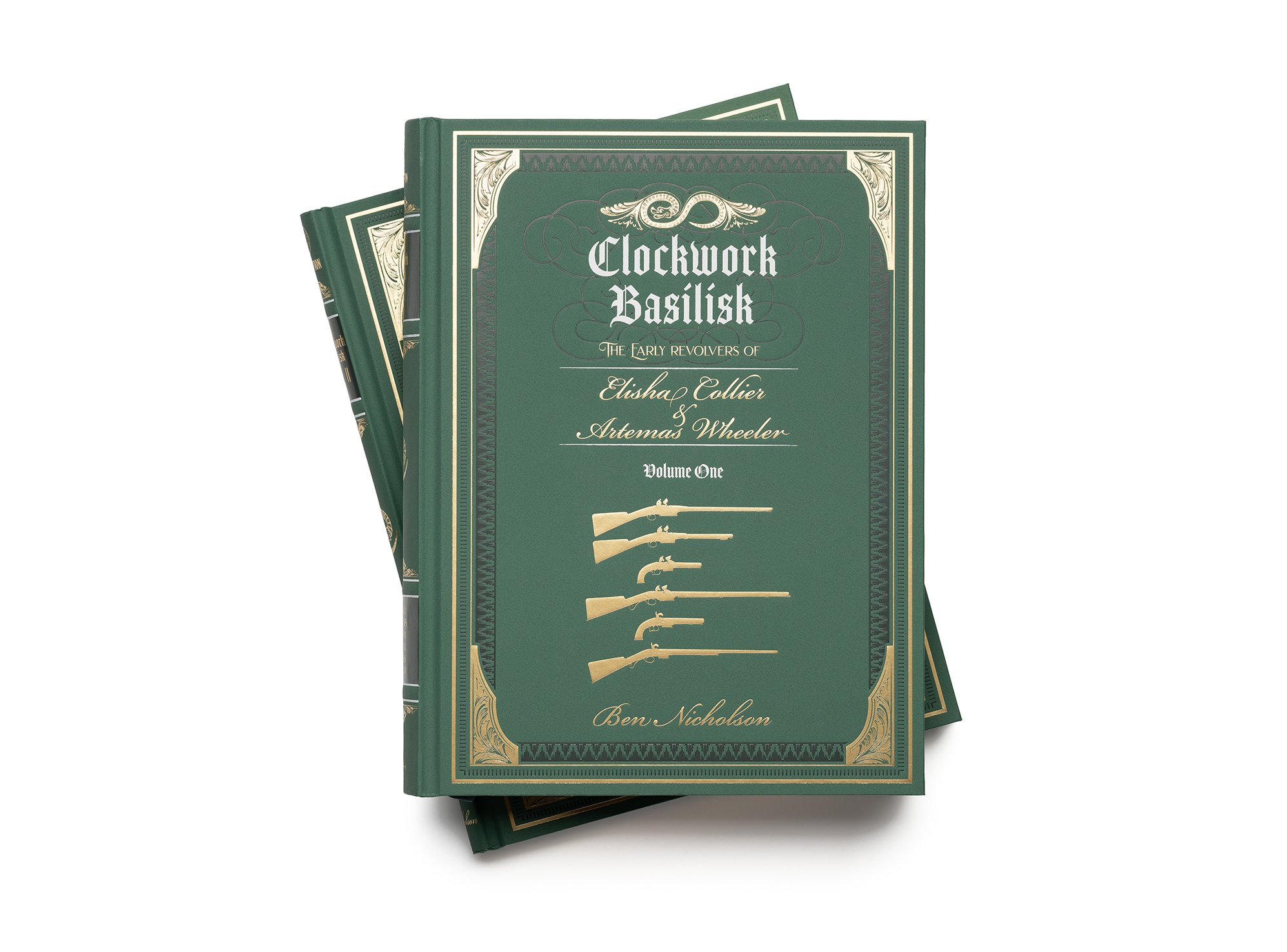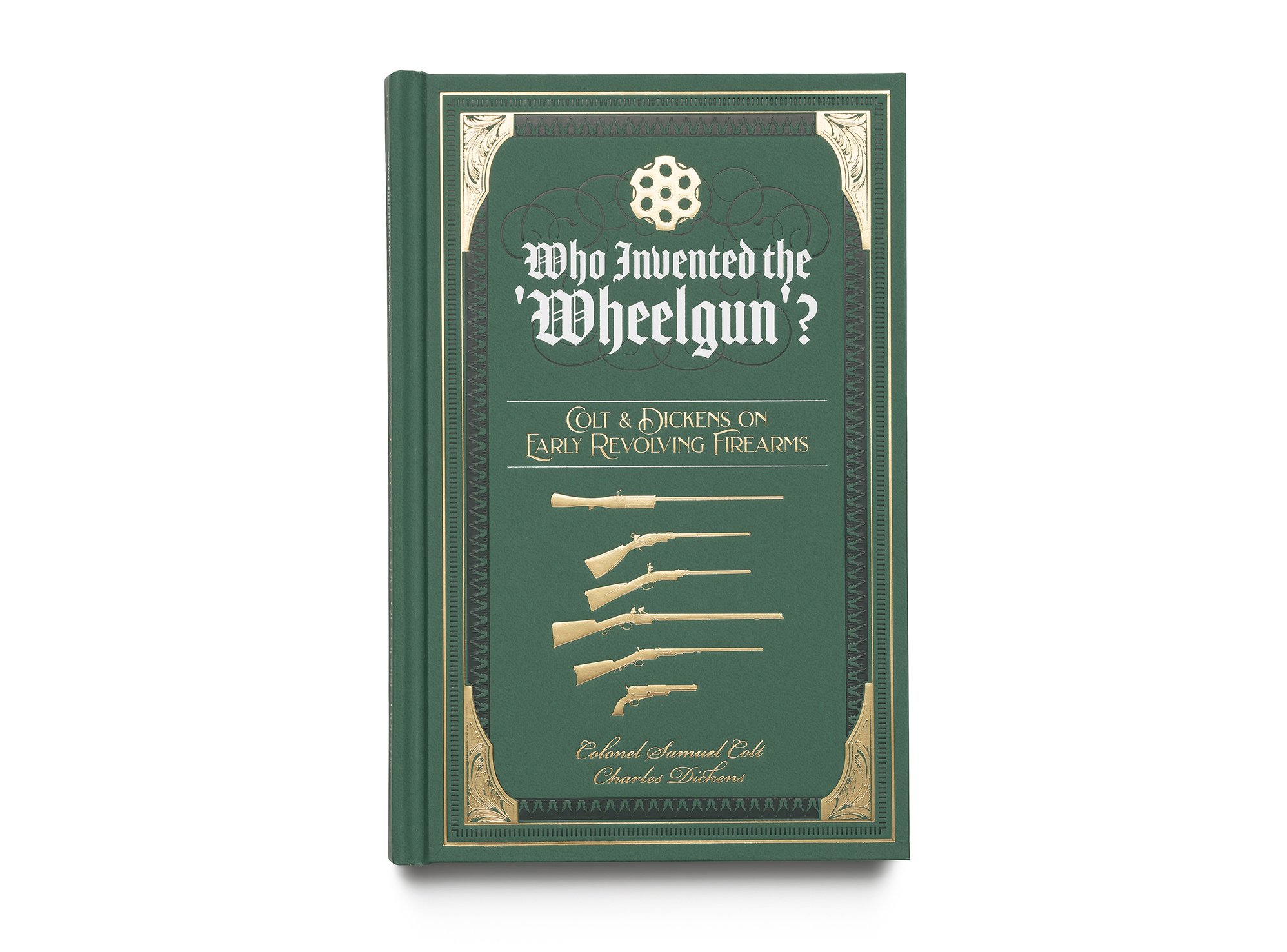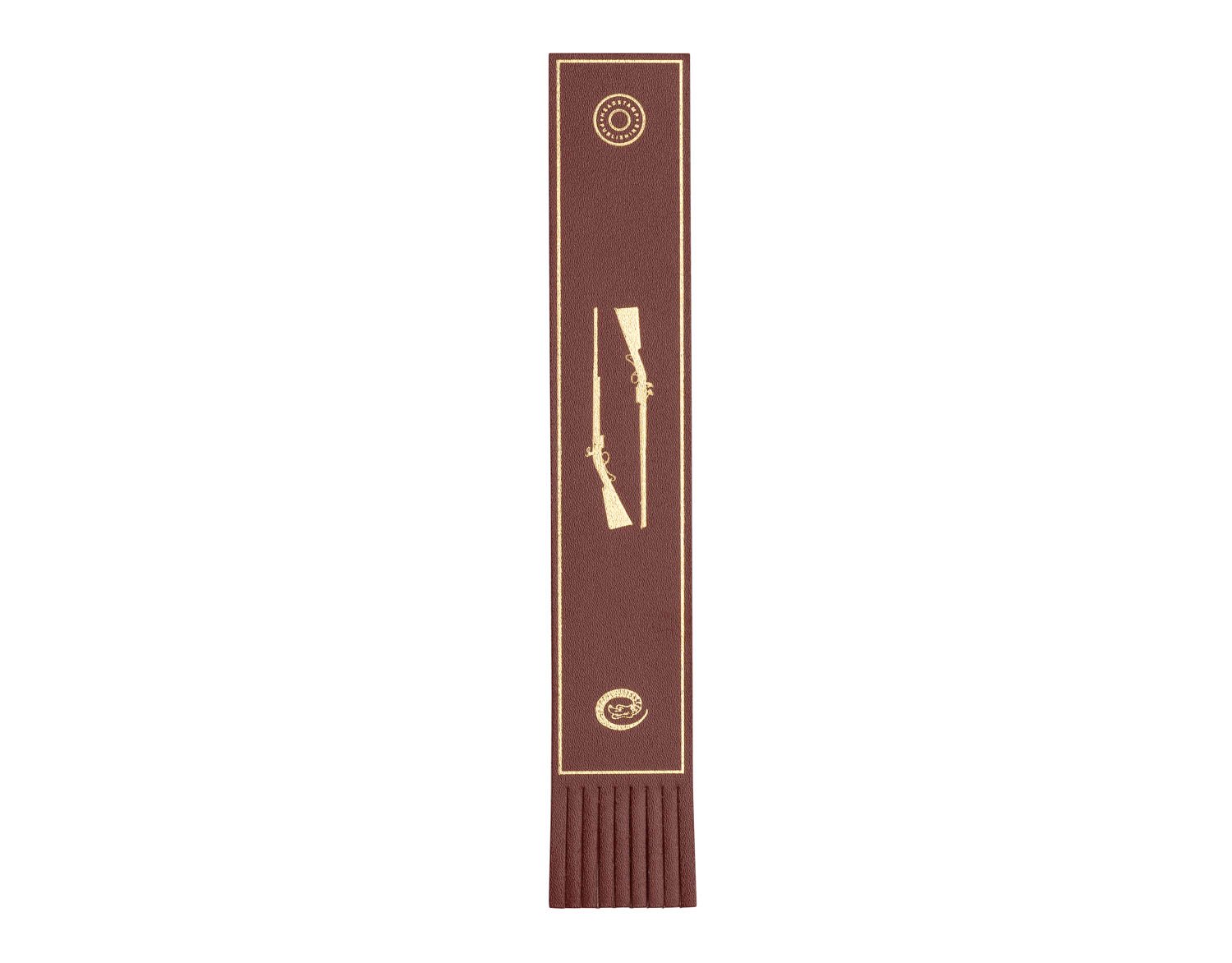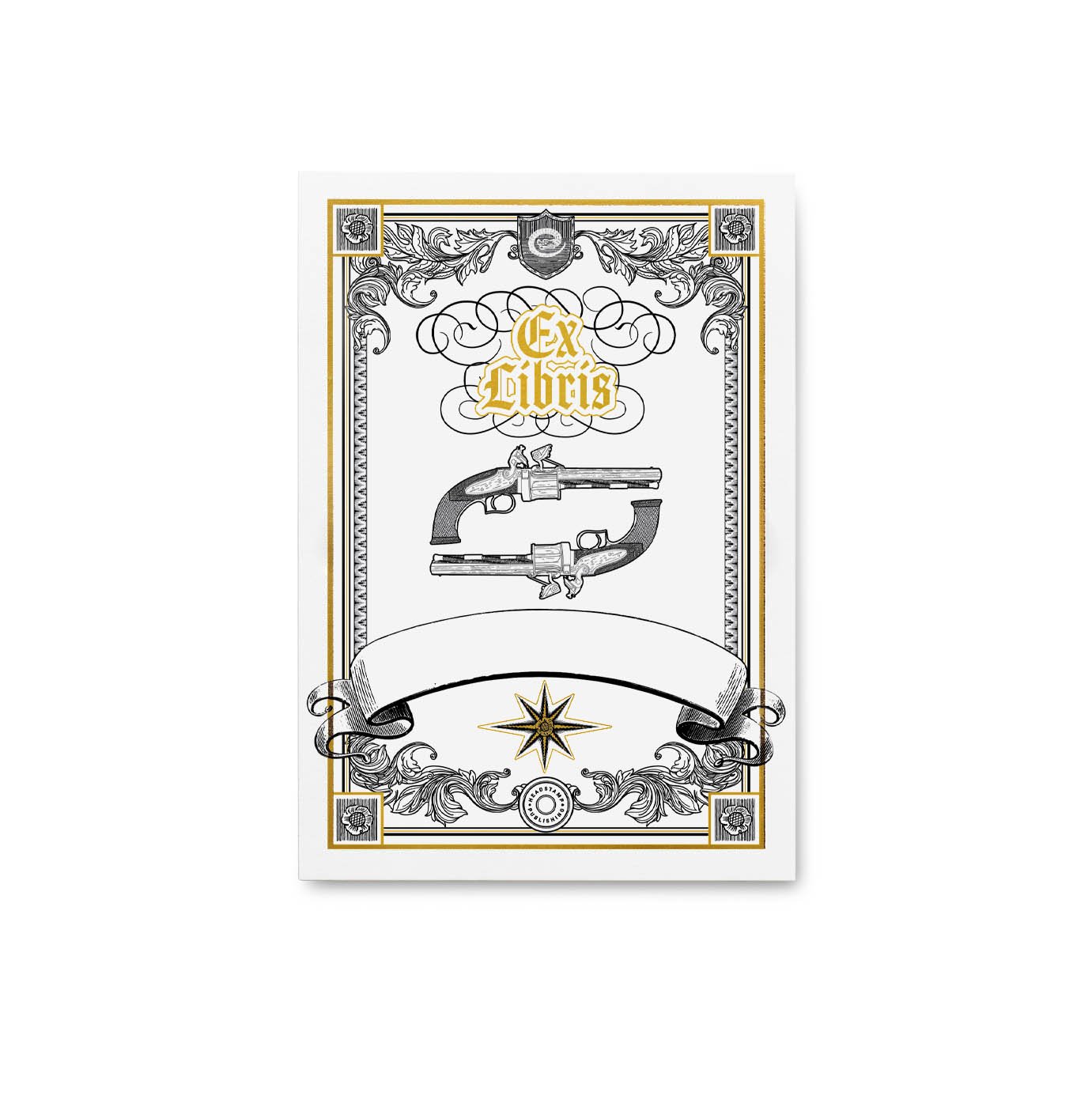CLOCKWORK BASILISK: The Early Revolvers of Elisha Collier & Artemas Wheeler
by Ben E. Nicholson
Clockwork Basilisk: The Early Revolvers of Elisha Collier & Artemas Wheeler reveals the first attempt to put a multi-shot firearm in the hands of the common soldier and sportsman. This novel device—patented in America in 1818 by Artemas Wheeler—was taken to England by his partner, Elisha Collier, to be trialed by the military shortly after the Napoleonic wars. Rejected by both the British and French militaries, the Collier revolver with its clockwork-advanced cylinder eventually found its place as a bespoke self-defense and hunting weapon.
Across two volumes, the book’s thirteen chapters trace the life of the design, including:
280 years of revolver design from the 1530s to the 1810s;
Prototype phase of First Model manual- and clockwork-advance Collier designs;
An explanation of the Patent, supported by digital cutaway drawings created by World of Guns;
Military versions presented to the American, British, and French armies and navies;
Bespoke Second Model flintlock Colliers produced for the gentry;
The transition from hand-building to partial machine production;
Third Model Collier—the first percussion revolver;
The decoration of the Collier with symbolic motifs;
Elisha Collier’s nine engineering patents; and
Collier’s design as exposed in Samuel Colt’s revolver lawsuits.
Seven appendices complement the text. They include a catalogue raisonné, timeline, broadsheets, the case label, the British Patent, parts lists, and key passages from the 1851–1852 Colt trials. An animated digital Collier has been created in cooperation with the digital project World of Guns, revealing its operation and disassembly.
Clockwork Basilisk sets a new standard for an academic firearms publication, combining rigorous original scholarship—supported by facsimile documents—with beautiful presentation and the very latest in digital object interactions. It is equally accessible to all generations of firearm enthusiasts. The book’s meticulous production is an even match for these rare weapons, of which fewer than 250 were made.
Companion Book
Commemorative Items
Backer Patch (Clockwork Basilisk)
Only Available During Pre-Order Campaign
About the Author
Ben E. Nicholson is Professor Emeritus at The School of the Art Institute of Chicago, and his career has engaged architecture, art, design, and popular culture. Exhibitions and publications include his designs of visionary houses, primitive geometry, labyrinths, and landscapes. Research publications are on the artist Michelangelo, Modern architecture in New Harmony, military culture and include articles in Man at Arms for the Gun and Sword Collector and guest editing CLOG + GUNS. Ben taught a class on firearms at The School of the Art Institute Chicago from 2015–2019 and at Cornell University in 2017. He divides his time between New Harmony, Indiana and Melbourne, Australia.
About the Contributors
Jonathan S. Ferguson is Keeper of Firearms & Artillery, based at the Royal Armouries Museum in Leeds. Jonathan has curated numerous displays, including the 2021 opening of the RA permanent exhibition Firefight: Second World War, and serves as a Technical Specialist for Armament Research Services and Associate Editor for Armax: The Journal of Contemporary Arms. His research interests include the use and effect of firearms and their depiction in popular culture. His publications include the book The ‘Broomhandle’ Mauser (2017), the chapter ‘“You Never Dreamt of a Poysoned Bullet”: “Forbidden” Ammunition from the Sixteen Century to the Present’ in A Right to Bear Arms?: The Contested Role of History in Contemporary Debates on the Second Amendment (2019), and Thorneycroft to SA80: British Bullpup Firearms, 1901–2020 (2021).
Frank N. Graves retired from architecture and real estate development in 2005. He has been a firearms collector, researcher, and writer since he was 12. He has published in The Texas Gun Collector, The Rampant Colt, The Gun Report, Arms Heritage Magazine, and Man at Arms for the Gun and Sword Collector. He has contributed to and edited four books on Colt, including The Colt Walker Army Revolver (2021) and The Colt Model 1860 Army Revolver (2018). He owns Collier Second Model Flintlock Revolver No. 89. His collection has won top awards from the Colt Collectors Association, the Texas Gun Collectors Association, and the National Rifle Association. He resides in the United States.
John R. McLean is retired following an extensive career in the design & construction of Building Services. He has been associated with Australian arms collecting groups since 1967, with a particular interest in firearms of Australia's colonial era. John has self-published several works on Australian colonial firearms and has assisted the Collier project with research in Australia, New Zealand, and elsewhere.
Matthew Schneiderman is a retired primary-care internist based in Los Angeles. Firmly embedded in the antique arms world since age 11, he collects, researches, and writes about early firearms of Great Britain, Ireland, and Continental Europe, with a special interest in unusual systems and designs. His many articles for The Gun Report, Arms Heritage Magazine and Bulletin of the American Society of Arms Collectors include: definitive studies of Edwin Budding, Samuel Pauly, Charles Moore, and William, Samuel & Charles Smith; explorations of Firearms Curiosa and Armes Insolites; a series on fulminate propulsion; and the mysterious practice of Collecting.
David J. Williams is a retired engineering academic and Emeritus Professor currently living in Norfolk. He has many years of industrial and research experience in manufacturing. His interests include gunmaking and British military firearms. He is widely published; his book The Birmingham Gun Trade is well known. He is an Honorary Historical Consultant to the Royal Armouries and President of the Arms and Armour Society and Honorary Editor of its journal. He brought both engineering experience and the insights gained in more than two decades of active research on the design and manufacture of English firearms to the work of the Collier project.

















